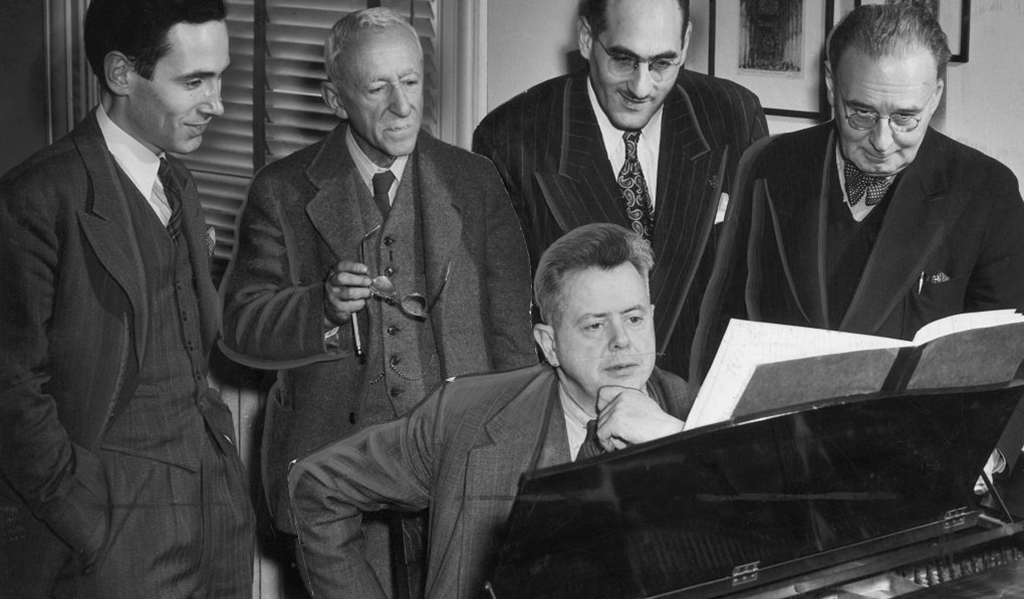Innovators. Renegades. Pioneers. Canadian musicians have long punched above their weight both at home and internationally. The history of music in our country is filled with bold and surprising moments. Here are some of them.

Canadian Music Timeline
2017
Canada Mosaic
2016
Drake releases his
fourth studio album, Views
2016
Yannick Nézet-Séguin named Music Director of the Metropolitan Opera
2014
Tanya Tagaq wins the Polaris Music Prize
2013
Mychael Danna wins an Oscar and Golden Globe for Life of Pi score
2006
Four Seasons Centre for the Performing Arts opens in Toronto
1999
Howard Cable appointed member of the Order of Canada

His remarkable career spanned over 70 years, working with everyone from Canadian Brass to Sharon, Lois & Bram and producing shows for Expo 67 and the Canadian National Exhibition.
1999
Céline Dion’s “My Heart Will Go On” wins two GRAMMY® Awards
1997
Lilith Fair goes on tour

It was the most successful all-female touring music festival in history. Spearheaded by Sarah McLachlan, it included Canadian stars like Diana Krall, Chantal Kreviazuk, and Nelly Furtado.
1996
Canadian women dominate the GRAMMY® Awards
1985
Angela Hewitt wins Toronto International Bach Competition

A Canadian star is introduced to the world. The young pianist dazzled the international jury with her sensitive Bach performances. She came out on top, winning a record deal, international tour, and cash prize.
1984
Leonard Cohen releases “Hallelujah”
1983
Claude Vivier murdered in Paris
1983
The Tragically Hip forms in Kingston
After over three decades of recording and touring, the band performed its final concert in August 2016 in Kingston.
1981
Rush releases Moving Pictures
1980
“O Canada” becomes official national anthem
It was written 100 hundred years earlier as a "chant national" and was the de facto anthem until decades of legislative attempts culminated with the official proclamation and Royal Assent in 1980.
1980
Healey Willan & Emma Albani become first Canadian musicians featured on a Canada Post stamp

1979
National Film Board releases Log Driver’s Waltz
The popular short features the voices of Kate & Anna McGarrigle and is Canadian as maple syrup.




1978
TSO becomes the first Canadian orchestra to tour China after the Cultural Revolution
Soloists Maureen Forrester and Louis Lortie joined Sir Andrew Davis on a landmark cultural exchange.
1971
Joni Mitchell releases Blue
1971
R. Murray Schafer composes No Longer Than 10 Minutes

It was the composer’s witty response to a special request from the TSO. Schafer is best known for his work in acoustic ecology through his World Soundscape Project and landmark book, The Tuning of the World.
1970
Anne Murray’s “Snowbird” is certified gold by the RIAA
1970
The Guess Who releases “American Woman”
1969
Ottawa’s Paul Anka pens “My Way” for Frank Sinatra
1968
Robert Charlebois releases “Lindberg”
1965
Anne of Green Gables–The Musical opens in PEI

1964
Buffy Sainte-Marie releases “Universal Soldier”

1964
Glenn Gould’s final public concert
He was a genius, innovator, and international superstar. The legendary Canadian pianist had a rare gift for captivating the world with recordings and performances that were distinctly original. But the concert hall wasn't for him. "I detest audiences," confessed Gould. His final public performance took place in Los Angeles before turning his attention to the recording studio.
1962
Oscar Peterson writes “Hymn To Freedom”

It became a crusade song of the civil rights movement led by Martin Luther King Jr., and is frequently performed by choirs worldwide.
1960
The rise of Canadian female composers

Women played an increasingly important part in Canadian musical life in the 1960s. Composers including Violet Archer, Barbara Pentland, and Ann Southam held key university posts and received commissions from major institutions across the country. Says Archer: “I was so deeply involved in making music that I couldn’t spend time worrying about not being a man.”
1949
Newfoundland joins Confederation
1945
Hugh Le Caine invents the “electronic sackbut”

Le Caine, the Canadian hero of electronic music, built the world’s first voltage-controlled synthesizer using a tiny desk.
1939
10-year-old André Mathieu of Montreal performs his own composition in Paris

One critic exclaimed, “I declare that at the same age Mozart had written nothing comparable."
1939
John Weinzweig writes Canada’s first twelve-tone composition

It was a bold move. In his Suite for Piano No. 1, Weinzweig was among the first Canadian composers to experiment with serialism. He fought to have it taught at The Royal Conservatory and succeeded, introducing an entire generation of Canadian composers to a new musical language.
1939
Claude Champagne returns to Montreal

After rubbing shoulders with Paul Dukas and Vincent D’Indy in Paris, Champagne returned to Montreal to teach and compose. He trained the next generation of Canadian composers and became one of the most well-known composers in the country.
1923
Toronto Symphony Orchestra forms

The New Symphony Orchestra under the Viennese-born conductor Luigi von Kunits gives its first concert on April 23. It is the successor to Frank Welsman's Toronto Symphony Orchestra, which was formed in 1906 but disbanded in 1918 due to the First World War. In 1927, the New Symphony Orchestra inherits the charter from Welsman's orchestra and is renamed the Toronto Symphony Orchestra.
1920
Robert Nathaniel Dett writes essay “The Emancipation of Negro Music”

The Canadian-born composer and performer won the prestigious Bowdoin Prize from Harvard University for his groundbreaking thesis.



1918
Sir Ernest MacMillan earns Oxford doctorate while interned as prisoner of war
While studying in Europe during WWI, he was interned for nearly five years as a prisoner of war in Germany. He became de facto music director at the Ruhleben internment camp, and led performances using parts he transcribed himself. In addition, he gave lecture performances and composed works that led to the Oxford degree. Upon returning to Canada he worked as an organist and choirmaster, and was TSO Music Director for over two decades.
1902
Oldest orchestra in Canada formed
1890
Canadian piano boom begins

Canadian pianos earned a reputation for being strongly built to withstand harsh climates. As the population grew and prospered, more Canadians wanted pianos in their homes. The industry employed 5,000 people, and produced tens of thousands of instruments each year during the next quarter century. During WWI, Canadian women rolled up their sleeves and worked in the factories, earning the same wages as the men.


